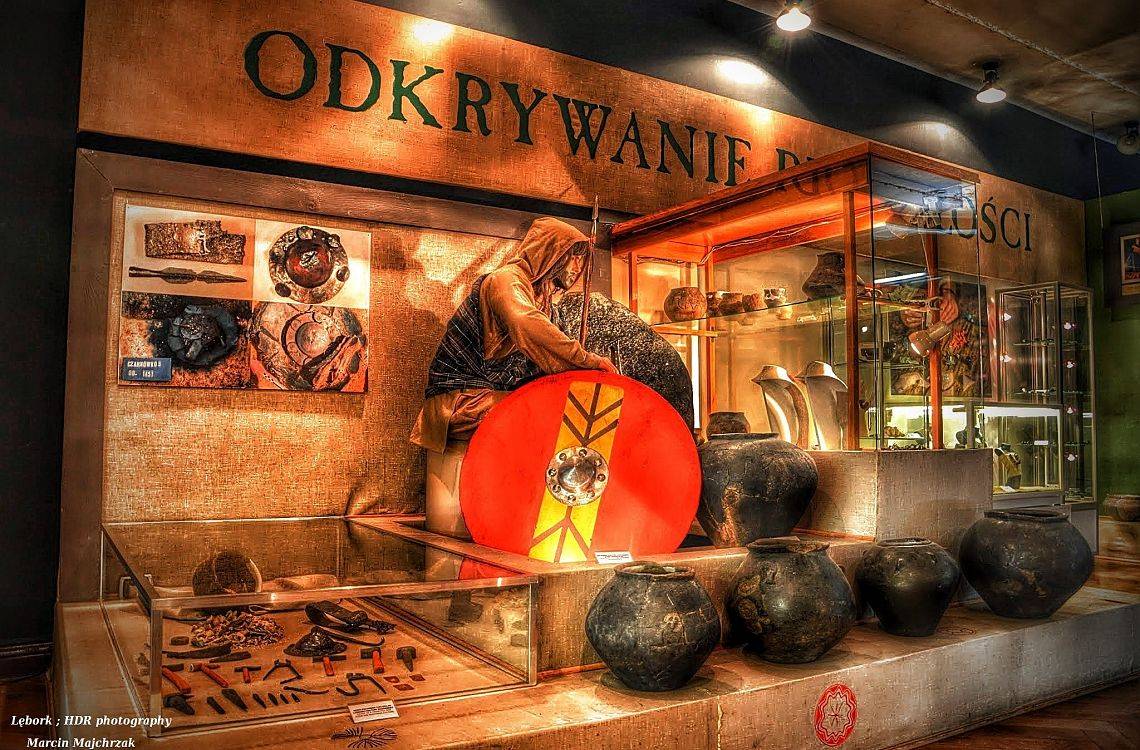Archeology
Archeology
The exhibition takes us back to ancient times, where the last glacial period in Northern Europe and the northern part of Central Europe, called the Vistula glaciation, finally recedes about 10,000 years B.C.E. More favorable climatic conditions meant it was possible for nomadic hunter-gatherer tribes to settle these areas, including Pomerania, by the first Mesolithic (10,000-5,400 years B.C.E.). They used tools, the working part of which was made of stone, including hatchets, axes, as well as arrows or spears with stone tips. About 5500 B.C.E. significant changes occurred, associated with the arrival of the first agricultural tribes. Plant cultivation and animal husbandry marks a new period of the Stone Age - the Neolithic (5500-1900 years B.C.E.). These skills resulted in further changes, such as a settled lifestyle or the use of clay pots.
In 3000/2000 B.C.E. the first metal products imported from the south appeared in the territory of present-day Poland, and over time local metallurgical production developed. Bronze became the main raw material for the production of tools and other items. The Bronze Age is not only about technological innovations, but also changes in the belief system as observed by archaeologists. A solar cult developed, based on the belief in the divine power of the sun and fire. The practice of cremation, which had been popular since the middle of the Bronze Age, is probably related to these beliefs.
In about 750 B.C.E, in the lands of what is today Poland, iron was increasingly used to make tools or weapons - hence the Iron Age. However, iron did not completely replace bronze. Under the influence of highly developed cultures from southern Europe (including Etruscan cultures), a transformation in funeral rites began in Poland. For the first time in prehistory, the production of special clay vessels intended solely for burying the burnt remains of the dead can be seen. In many cases they have the image of a human face (urns or face urns). The surfaces of the vessels were often decorated with magical - symbolic engraved images such as coniferous branches, the sun, stars, the moon or water waves. The material traces of these people's activities are called the Pomeranian culture. From the 2nd century B.C.E. there are visible changes that occurred as a result of the influence of Celtic tribes, known as the process of “Latenization”. It was then that economic development took place, in particular the development of iron metallurgy. New cultural trends are also reflected in funeral rites, in which there are male burials with ritually destroyed weapons. This is how a new cultural unit developed - the Oksywie culture.
The period of Roman influence (20-375 C.E.) is when a new military, political and economic power appears on the international arena - the Roman Empire, whose expansion to the north and east began in the 1st century B.C.E. At the beginning of our era, Pomerania was inhabited by tribes whose material remains archaeologists call the Oksywie culture. However, the situation at that time was dynamic. According to the ancient chronicler Jordanes in his work Gethica, the tribes of Germanic Goths led by King Berig crossed the sea reaching the land of Gotiskandza, identified by researchers as the southern coast of the Baltic Sea. As a result of the assimilation of newcomers with the local population, significant changes took place - a fairly dense settlement network was established, and the cultural model also changed. This is how the Wielbark culture crystallized, which at the beginning occupied the area of Pomerania and the Vistula estuary, and in 2 C.E. part of its population set off on a great journey reaching the territory of today's western Ukraine.
One of the largest necropolises of the Wielbark culture was discovered in Czarnówko - a village near Lębork. This site provided many unique artefacts and valuable information. It is a bi-ritual burial ground, which means that the dead were buried in both cremation and inhumation rituals, where the body was often placed in a coffin made of a hollow log. In these burials, many items of grave equipment were found, including elements of costumes, ornaments1, small everyday items2, and clay vessels. The most common are items made of bronze (clasps, buckles, bracelets), but there are also more impressive precious metals - gold and silver (clasps, pendants, bracelets, beads3). These products were produced by local, Germanic craftsmen. Among the items found at the site in Czarnówko, special attention should be paid to luxury products imported from Roman provinces - bronze and glassware4, including a world-unique bronze cauldron with images of Sweba5, a glass bottle in the shape of a fish6 and a glass goblet with images of water birds7. The rich or magnificent furnishings of the tomb may testify to the exceptional, high position of the deceased in their community 8,9 . The range of products given to the buried is very wide, but limited. There was a prohibition which applied to weapons and tools, and these we do not find in the graves of the Wielbark culture.
The end of the Wielbark culture marks the beginning of the migration period of peoples beginning at the end of the 4th century C.E. Sudden, extensive changes in the settlement structure take place throughout the continent, probably due to the Hun invasions, and in the longer term the emergence and spread of the Slavs.
